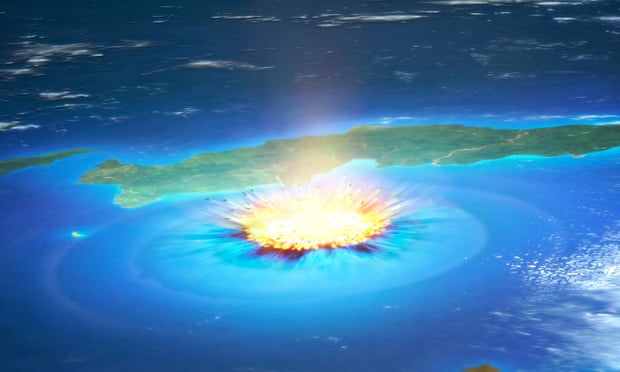SILVER LINING
Terrawatch: how mass extinctions can spur on evolutionEvidence from 252m years ago shows surviving animals bounced back stronger, fitter, faster and smarter

The asteroid impact believed to have led to the death of the dinosaurs was one of Earth’s many mass-extinction events. Photograph: Science Photo Library/Alamy
Kate Ravilious
@katerav
Wed 27 Jul 2022
Mass extinctions are not all bad news: survivors bounce back stronger, fitter, faster and smarter than before. Palaeontologists studying the most deadly mass extinction of all time – the end-Permian, 252m years ago – have shown that predators rapidly became swifter and more deadly, while prey animals adapted and found new ways to survive.
Incredible fossil fish assemblages from China reveal that new hunting modes emerged earlier than previously thought, including fish with masses of teeth, adapted to crushing shells, and streamlined “lizard” fish that specialised in ambush, shooting out from murky lairs. Meanwhile, the animals that they preyed upon had to develop defences. “Some got thicker shells, or developed spines, or themselves became faster in order to help them escape,” said Feixiang Wu, from the Chinese Academy of Sciences in Beijing, whose findings are reported in Frontiers in Earth Science.
On land the reptiles became faster, while mammals and birds became warm-blooded, enabling them to move faster for longer periods of time. “Mass extinctions of course were terrible news for all the victims. But the mass clearout of ecosystems gave huge numbers of opportunities for the biosphere to rebuild itself, and it did so at higher octane than before the crisis,” says Michael Benton from the University of Bristol.
Kate Ravilious
@katerav
Wed 27 Jul 2022
Mass extinctions are not all bad news: survivors bounce back stronger, fitter, faster and smarter than before. Palaeontologists studying the most deadly mass extinction of all time – the end-Permian, 252m years ago – have shown that predators rapidly became swifter and more deadly, while prey animals adapted and found new ways to survive.
Incredible fossil fish assemblages from China reveal that new hunting modes emerged earlier than previously thought, including fish with masses of teeth, adapted to crushing shells, and streamlined “lizard” fish that specialised in ambush, shooting out from murky lairs. Meanwhile, the animals that they preyed upon had to develop defences. “Some got thicker shells, or developed spines, or themselves became faster in order to help them escape,” said Feixiang Wu, from the Chinese Academy of Sciences in Beijing, whose findings are reported in Frontiers in Earth Science.
On land the reptiles became faster, while mammals and birds became warm-blooded, enabling them to move faster for longer periods of time. “Mass extinctions of course were terrible news for all the victims. But the mass clearout of ecosystems gave huge numbers of opportunities for the biosphere to rebuild itself, and it did so at higher octane than before the crisis,” says Michael Benton from the University of Bristol.
No comments:
Post a Comment